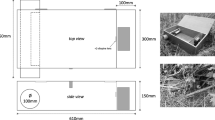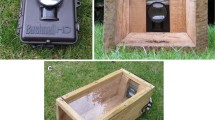Abstract
The success of group biomarking with rhodamine B (RB) is determined by two key stages—baiting and mark detection. This work has two objectives: (1) to examine the suitability of a new bait type and the proposed experimental procedures for marking small mammals with RB and (2) to evaluate the effectiveness of the new method of RB detection in field studies of small mammals. Uniquely designed bait with RB was placed in nine rectangular plots in forest stands. The experiments differed in the area of the marking plots, application rate of the bait, and the time interval before the start of animal trapping. Small mammals were captured and evaluated in a dark room for the presence of RB markings. A green laser with a diffuser was used as the illuminator to excite fluorescence, and orange glass was used for separation of the emission spectrum. The new method for the detection of RB was shown to be simple and reliable. The bait used in this study was proven to be effective and is potentially suitable for most species of small mammals, especially rodents, under certain conditions.


Similar content being viewed by others
References
Ballesteros C, Sage M, Fisher P, Massei J, Mateo R, De La Fuente J, Rossi S, Gortázar S (2013) Iophenoxic acid as a bait marker for wild mammals: efficacy and safety considerations. Mammal Rev 43:156–166
Bennett AF (2003) Linkages in the landscape. The role of corridors and connectivity in wildlife conservation. IUCN, Gland and Cambridge
Bentley JM (2008) Role of movement, interremnant dispersal and edge effects in determining sensitivity to habitat fragmentation in two forest-dependent rodents. Austral Ecology 33:184–196
Betts MG, Gutzwiller KJ, Smith MJ, Robinson WD, Hadley AS (2015) Improving inferences about functional connectivity from animal translocation experiments. Landsc Ecol 30:585–593
Bowne DR, Bowers MA (2004) Interpatch movements in spatially structured populations: a literature review. Landsc Ecol 19:1–20
Crier JK (1970) Tetracyclines as a fluorescent marker in bones and teeth of rodents. J Wildl Manag 34:829–834
D’Amico M, Clevenger AP, Roman J, Revilla E (2015) General versus specific surveys: estimating the suitability of different road-crossing structures for small mammals. J Wildl Manag 79:854–860
Duggan JM, Heske EJ, Schooley RL, Hurt A, Whitelaw A (2011) Comparing detection dog and livetrapping surveys for a cryptic rodent. J Wildl Manag 75:1209–1217
Fernandez JR-R, Rocke TE (2011) Use of Rhodamine B as a biomarker for oral plague vaccination of prairie dogs. J Wildl Dis 47:765–768
Fichet-Calvet E (1999) Persistence of a systemic labelling in fur and guard hairs by ingestion of rhodamine B in Myocastor coypus (Rodentia). Mammalia 63:241–244
Fisher P (1999) Review of using Rhodamine B as a marker for wildlife studies. Wildl Soc Bull 27:318–329
Fisher P, Algar D, Sinagra J (1999) Use of Rhodamine B as a systemic bait marker for feral cats (Felis catus). Wildl Res 26:281–285
Grigorkina EB, Olenev GV (2013) Migration of rodents in the eastern Urals radioactive trace zone (radiobiological aspect). Radiat Biol Radioecol 53:76–83 (in Russian)
Hanski I, Gaggiotti OE (2004) Ecology, genetics and evolution of metapopulations. Elsevier Academic Press, Amsterdam
Hanski I, Gilpin M (1991) Metapopulation dynamics: brief history and conceptual domain. Biol J Linn Soc 42:3–16
Inoue T, Nonaka N, Kanai Y, Iwaki T, Kamiya M, Oku Y (2007) The use of tetracycline in anthelmintic baits to assess baiting rate and drug efficacy against Echinococcus multilocularis in foxes. Vet Parasitol 150:88–96
Jacob J, Jones DA, Singleton GR (2002) Retention of the bait marker Rhodamine B in wild house mice. Wildl Res 29:159–164
Jacob J, Ylonen H, Runcie MJ, Jones DA, Singleton GR (2003) What affects bait uptake by house mice in Australian grain fields? J Wildl Manag 67:341–351
Kadoya T (2009) Assessing functional connectivity using empirical data. Popul Ecol 51:5–15
Klevezal GA, Mina MV (1980) Tetracycline method of group marking for rodents and prospect of its utilization in ecological studies. Zoologicheskii Zhurnal 59:936–941 (in Russian)
Lindsey GD, Nass RD, Hood GA (1971) An evaluation of bait stations for controlling rats in sugarcane. J Wildl Manag 35:440–444
Linn IJ (1978) Radioactive techniques for small mammal marking. In: Stonehouse B (ed) Animal marking. Recognition Marking of Animals in Research. The Macmillan press LTD, London, pp 177–191
Massei G, Jones A, Platt T, Cowan DP (2009) Iophenoxic acid as a long-term marker for wild boar. J Wildl Manag 73:458–461
Matter HC, Schumacher CL, Kharmachi H, Hammami S, Tlatli A, Jemli J, Mrabet L, Meslin FX, Aubert MF, Neuenschwander BE, Hicheri KE (1998) Field evaluation of two bait delivery systems for the oral immunization of dogs against rabies in Tunisia. Vaccine 16:657–665
Mohr K, Leirs H, Katakweba A, Machang’u R (2007) Monitoring rodents movements with a biomarker around introduction and feeding foci in an urban environment in Tanzania. Afr Zool 42:294–298
Papillon Y, Buffiere L, Butet A (2002) Rhodamine B as a collective marker for studying movements of small mammals. Acta Theriol 47:491–497
Peacock E, Titus K, Garshelis DL, Peacock MM, Kuc M (2011) Mark-recapture using tetracycline and genetics reveal record-high bear density. J Wildl Manag 75:1513–1520
Purdey DC, Petcu M, King CM (2003) A simplified protocol for detecting two systemic bait markers (Rhodamine B and iophenoxic acid) in small mammals. N Z J Zool 30:174–184
Reidy MM, Campbell TA, Hewitt DG (2011) A mark–recapture technique for monitoring feral swine populations. Rangel Ecol Manag 64:316–318
Slate D, Algeo TP, Nelson KM, Chipman RB, Donovan D, Blanton JD, Niezgoda M, Rupprecht CE (2009) Oral rabies vaccination in North America: opportunities, complexities, and challenges. PLoS Negl Trop Dis 3:1–9
Smyser TJ, Beasley JC, Olson ZH, Rhodes OE Jr (2010) Use of Rhodamine B to reveal patterns of interspecific competition and bait acceptance in raccoons. J Wildl Manag 74:1405–1416
Spurr EB (2002) Rhodamine B as a systemic hair marker for assessment of bait acceptance by stoats (Mustela erminea). N Z J Zool 29:187–194
Stenseth NC, Lidicker WZ Jr (1992) Animal dispersal. Springer Science+Business Media, Dordrecht
Szacki J, Liro A (1991) Movements of small mammals in the heterogeneous landscape. Landsc Ecol 5:219–224
Tolkachev OV (2016) The dispersal of the pygmy wood mouse (Sylvaemus uralensis Pallas, 1811) and the bank vole (Clethrionomys glareolus Schreber, 1780) in fragmented landscapes. Contemp Probl Ecol 9:116–124
Tolkachev OV, Bespamyatnykh EN (2018). New method of rhodamine mark detection and its application possibilities in zoological studies. Journal of Siberian Federal University. Biology. https://doi.org/10.17516/1997-1389-0051. (in press Online First: http://journal.sfu-kras.ru/en/article/71349)
Tripp DW, Rocke TE, Streich SP, Brown NL, Fernandez JR-R, Miller MW (2014) Season and application rates affect vaccine bait consumption by prairie dogs in Colorado and Utah, USA. J Wildl Dis 50:224–234
Turchin P (1998) Quantitative analysis of movement: measuring and modeling population redistribution in animals and plants. Sinauer Associates, Sunderland
Weerakoon MK, Price CJ, Banks PB (2013) Hair type, intake, and detection method influence Rhodamine B detectability. J Wildl Manag 77:306–312
Funding
This study was performed within the frameworks of state contract with the Institute of Plant and Animal Ecology, Ural Branch, Russian Academy of Sciences.
Author information
Authors and Affiliations
Corresponding author
Ethics declarations
Ethical approval
This research follows national guidelines for the care and use of animals. I did not use any unusual protocols that could contradict the generally accepted standards of animal care.
Conflict of interest
The author declares that he has no conflict of interest.
Additional information
Publisher’s Note
Springer Nature remains neutral with regard to jurisdictional claims in published maps and institutional affiliations.
Rights and permissions
About this article
Cite this article
Tolkachev, O. A new baiting scheme and simple method of rhodamine B detection could improve biomarking of small mammals. Eur J Wildl Res 65, 10 (2019). https://doi.org/10.1007/s10344-018-1243-5
Received:
Revised:
Accepted:
Published:
DOI: https://doi.org/10.1007/s10344-018-1243-5




